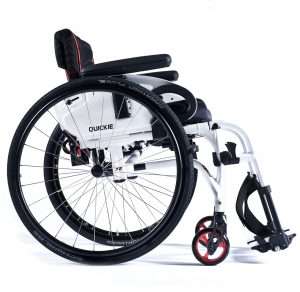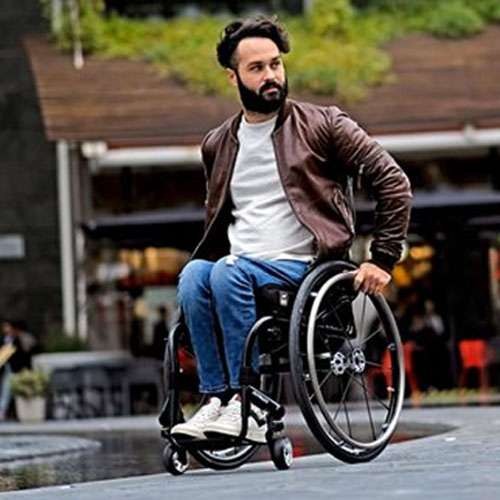Active user wheelchairs have a few key features which make them better for active users. This guide to active user wheelchairs will help you understand the differences, and who benefits most from one.
Active user wheelchairs have become more ubiquitous in recent years — they are popular with Parathletics and Paralympic athletes. They’re more lightweight and quicker than a traditional manual wheelchair, and they’re best-suited to users who have good upper body and trunk strength who are more independent in their day-to-day lives.
Who can use active user wheelchairs?
We often recommend that only people with good upper body strength and trunk stability use active wheelchairs. This is because active user wheelchairs are self-propelled, so you will need your strength to push yourself along.
As you can imagine, pushing an active user wheelchair (particularly up hills) means that there will be more movement in your core for propulsion power. Having good trunk and core strength is essential, as it helps you to keep your balance when pushing.
Having full range of movement in your arms is also necessary. This gives the individual more independence in their mobility, as they don’t require pushing and can determine their own pace and movement.

Active user wheelchairs are completely self-propelled, and users must have good trunk and upper body strength to be able to push themselves.
Smaller frames
One of the most defining features of active user wheelchairs is the compact frame size. Whilst some active user wheelchair frames can be folded down to save space, lots of them are completely rigid with a one-piece frame.
This is to maximise the amount of effort you put into pushing the chair. A folding mechanism in a wheelchair frame can make it a bit more difficult to propel forwards and manoeuvre, whereas a rigid frame is easier to handle.
Active user wheelchair frames are also remarkably lighter than a traditional attendant-propelled wheelchair. Lots of active user models are made using aluminium, which can sometimes be a bit more expensive, but a lot lighter than steel.
This makes the chair much easier to push and manoeuvre with less effort needed.
Bigger wheels
You’ll also notice that the rear wheels on an active user wheelchair are typically larger than those on a traditional manual wheelchair. This makes it much easier for the user to reach the wheels and push themselves forward.
Larger wheels also maximise the amount of effort exerted when pushing the chair. The user can use a larger range of motion to generate more forward momentum, therefore getting more movement out of their active wheelchair.
The rear wheels can also be moved forward so that the front castors can be lifted off the ground with ease, making it simpler to navigate kerbs and rough terrain.
The wheels of an active user wheelchair can also be cambered. This means that they are fixed to the chair at an angle, with the bottom of the wheel being slightly further out than the top section. This makes the chair even easier to manoeuvre.

Self-propelled wheelchairs will always have larger back wheels to allow the individual to push themselves along with ease.
Lower backrests
Active user wheelchairs also have a lower backrest than other models. This is to give more room around the upper back and shoulders so that the individual can push themselves without having to worry about bashing into the backrest.
The backrest on an active user chair is low enough to facilitate upper body movement and propulsion, but it also provides sufficient lumbar support as well.
Summary
This is a brief overview of active user wheelchairs and their key features, and we hope it’s given you a better idea of what to expect with these models. Whilst they do offer more independence and mobility to individuals, we highly recommend that you speak to an active wheelchair specialist before buying one to make sure that it’s the right model for you.
That being said, there is now a range of powered wheelchair add-ons that gives users, who previously weren’t able to use active user wheelchairs, the ability to be more independent despite reduced trunk strength. Nevertheless, we would always say to have an assessment first and always reference this guide to active user wheelchairs if necessary.














